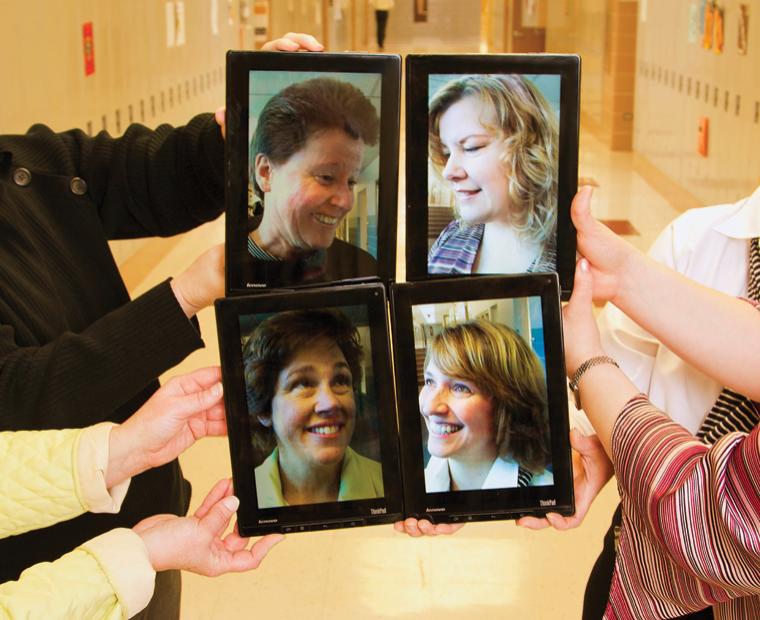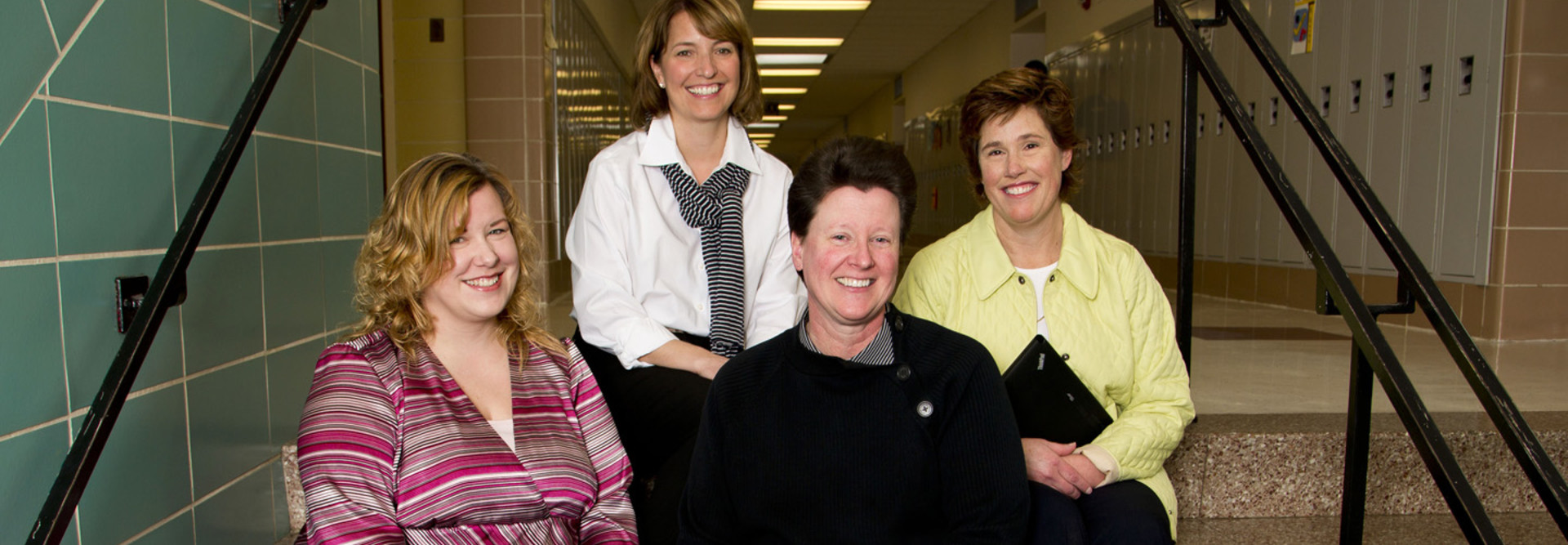What Other Schools Can Learn from Carmel Catholic’s One-to-One Experience
Dr. Judith Mucheck has a saying that, she admits, drives people a little crazy: "You don't get a prize for finishing first. But you do get a prize for finishing well." Rather than leaping to action, Mucheck, president of Carmel Catholic High School in Mundelein, Ill., likes to know what she's getting into. "Sometimes," she says, "you have to be comfortable saying, 'We don't know, but we will, so stay tuned.' "
In the case of Carmel Catholic's one-to-one tablet program, the school community stayed tuned for four years while school leaders developed a plan, wired the campus, built the infrastructure and trained faculty to use the devices. When the school finally issued Lenovo ThinkPad tablets to all 1,400 students last fall, "it went amazingly smoothly because we had been preparing for it for so long," Mucheck says.
See Carmel's One-to-One in Action
Carmel Catholic High School leaders reflect on the process of developing their one-to-one and Demo Days programs in this EdTech: Focus on K–12 video. To complete the CDW•G One-to-One Readiness Assessment Survey mentioned in the video, visit cdwg.com/1to1readiness.
Almost immediately, school officials started fielding calls from other schools interested in seeing the one-to-one program in action. Staff members wanted to share the wisdom they had gained from their experience, but they didn't want visits to disrupt classes. So they decided to host 10 "Demo Days" for outside educators to visit the school, hear how the one-to-one program was developed and even sit in on classes.
The events "are going to save a lot of people a lot of time and energy," says Jo Marie Yonkus, assistant superintendent for high schools with the Archdiocese of Chicago, who attended a Demo Day last fall. "They did a beautiful job. The organization of this one-to-one program was phenomenal."
Demo Days are valuable not only to visitors, who learn one-to-one best practices from peers with the luxury of hindsight, but also for Carmel Catholic's staff, who glean new ideas and perspectives from the educators who have traveled to their campus to learn from their experience.
"When a group of educators get together, they collaborate and get a richer experience," says Laura L. Budris, Carmel Catholic's associate principal of curriculum. "The insight and the sharing of ideas have been phenomenal. We are all in it together."
A Project Five Years in the Making
Marisue Lacher, a Carmel Catholic parent who volunteered to coordinate the Demo Days program, was impressed when she learned the one-to-one program's backstory. "As a parent, I think it's fascinating to see how much work and effort has gone into this," she says. "It's not technology for technology's sake. It was a well-thought-out process, and our students are benefiting."
Rather than just tell visitors what school officials are doing with the tablets, she worked with Carmel Catholic staff to build the three-and-a-half-hour program to show visitors how they got there. Mucheck opens the program by taking visitors back to 2006, when the school developed its strategic plan, which included implementing wireless.
Beginning in summer 2008, the technology team did some wiring and researched new infrastructure to ready for the move to a wireless campus. In summer 2010, they removed classroom desktop computers and gave every teacher a ThinkPad tablet. "We wanted to make sure that faculty were comfortable with the technology," Mucheck explains. "We didn't want them to start with nothing and say, 'You need to dial it from zero to 60 in a month.' "
During the 2010–2011 school year, they trained teachers on the basics. By the following year, teachers had to pass tests demonstrating skills such as understanding the rudiments of a spreadsheet and cutting and pasting text in email. It was easy for some, but others needed additional training. Today, all faculty members can navigate the Microsoft Office suite, email, Skype, instant messaging, electronic grade books and Edline, the learning community management system that Carmel Catholic uses. They also can build lesson plans that incorporate technology.
Each department assigned one faculty member as the go-to person for technology instruction. "They taught each other" within their disciplines, Mucheck says. "You didn't have a math teacher trying to teach English teachers."
Prepare for Takeoff

Credit: Darren Hauck
After years of planning, the final decision officials made was which device to get for students. According to Jane Hilliard, the school's associate principal of technology integration, they chose to lease Lenovo ThinkPad tablets for the following reasons:
- The devices work with the existing network infrastructure.
- Their $378-per-unit price tag (which included a tablet, keyboard, folio case and stylus pen) was half the cost of other tablets.
- They have both USB and HDMI ports.
- Their battery charge lasts throughout the school day.
- Both the devices and their cases are rugged enough for 14- to 18-year-olds.
CDW•G provided all the front- and back-end equipment and installed the servers. "They were like our third-level support," Hilliard says of CDW•G personnel, noting that they spent a week at the school installing the wireless access points and Citrix back-end equipment, in addition to helping with naming conventions, installing the new switches and upgrading the core switch.
Before issuing 1,400 tablets to students, Carmel Catholic High School's network had a throughput of 12Mbps.To accommodate their infrastructure upgrades, school officials boosted that throughput to 60Mbps.
"We couldn't have done it without the extra manpower," she adds. "If we hit a wall, we could call them, and that was so valuable."
So far, the one-to-one program has experienced few problems, and the response within the school community has been even better than expected. When Carmel Catholic administrators surveyed teachers, asking if the presence of tablets has changed their teaching in a positive way, 100 percent of them said yes.
"I'm not necessarily concerned that they're blazing trails," Mucheck says. "But is it having a positive effect? No one on the faculty is saying this is a bad idea. And that's because they were ready."
Carmel Allows Educators to Observe 21st Century Learning in Action
After the presentation, a lunch break and a video that shows students and teachers talking about how they use the tablets, Budris walks Demo Days guests through the school building to see the one-to-one program in action.
The walk-throughs are different each time because they aren't staged. Participants visit seven to 10 classrooms. In some classes, students are taking notes on the tablets or using them for activities, while in others, the tablets are stored away. "It's very clear that the tablet is just a tool," Budris says. "It's not the be-all and end-all" of their learning experience.
The tablets are used by different departments in a variety of ways, which Budris has chronicled in a list that she shares during each Demo Day. She describes as "genius" one activity she saw in a physical education class, in which students videotaped each other practicing tennis strokes, then broke into groups to analyze the angle of the racquet, the point it hits the ball and other factors affecting the stroke. "Really watching them give feedback to each other — not just relying on the teacher as a coach to give them feedback — was phenomenal," Budris explains.
Many classes use the tablets for basic functions, such as online research. That's nothing new, but now that all students have online access in class, teachers can offer guidance about navigating the overabundance of information available.
"One of the challenges we have is getting these kids to be critical consumers," says history teacher Julie Donner. "Before, they were on their own in this huge world of the Internet."
Donner also uses the tablets in class to administer online quizzes, which help her adjust her lesson plans when needed. For instance, if most students get one question wrong, but everyone gets another correct, she can spend extra time reviewing the concept they struggled with and skip over the one they aced.
Students also get instant feedback so they can correct problems immediately rather than waiting a day or two to find out they didn't grasp a concept. "It helps them become more efficient learners," Budris says.
Since students got their tablets, the response has been overwhelmingly positive. Hilliard acknowledges that she did get a couple of calls from parents complaining that their children are playing video games or surfing the web instead of doing homework during class. But the technology isn't the problem, she says.
"The student who's off task instant messaging this year was staring out the window or doodling last year," she explains.
In fact, school leaders have chosen to give students more freedom with their devices so they learn how to use them responsibly. "We're not tightening the reins," Hilliard adds. "We're teaching the harder lesson, which is to be responsible digital citizens."
Step by Step
Educators at Carmel Catholic High School in Mundelein, Ill., have put together a comprehensive program to share the lessons they learned while building the school's one-to-one tablet program. Before visiting classrooms, Demo Days participants hear school officials reflect on:
- the need for a one-to-one program;
- setting and measuring goals and creating a timeline;
- program design and financing, such as whether to roll the device out to all grades or just one, hardware and operating system choices, and owning versus leasing;
- infrastructure needs, including connectivity, servers, storage, integration with classroom devices, and power;
- software, imaging, updates and tracking devices;
- technical support;
- policies, such as school network usage;
- preparing faculty and integrating tablets into the curriculum;
- communicating about the project;
- rollout particulars; and
- problems, such as overheating in the server room and insufficient bandwidth.









